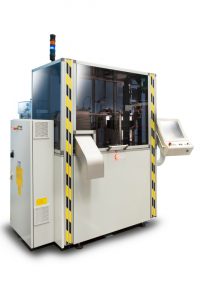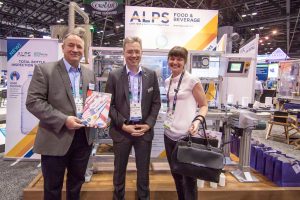A review of inspection systems
In this issue we focus on the manufacturers of inspection systems. We have asked them since when their company deals with inspection in the PET area (I), in which area of inspection they are active and where they see potential for further growth (II). We also asked them about their most exciting project and the challenges they face. (III)
Sacmi Imola S.C.
(I) “Sacmi sold its first PVS machine in 2005. This equipment was called PVS-1 and it was capable to inspect up to 30,000 preforms/hour for the following criteria: top seal, bottom and body. At this time we also introduced our patented “Grid inspection“ to identify defects usually visible with polarised light.

The reason for which we decided to invest in PET preform inspection came from the consideration that we already controlled the plastic caps at 360° and each cap is then paired to a bottle, so for sure inspecting the preform would have become an industrial need. Moreover, other factors push up our decision: the increased production speed, the introduction of big moulds (144 cavities), the use of rPET, the weight reduction. All these factors would have increased the possibility to create defects in big quantities.”
“Today we count on a wide range of machines for quality control of PET preforms that spans from the QC Lab (PVS-2) to the off-line inspection (PVS-3) or in-line (PVS-5) with a very compact equipment that can be easily integrated with any new or existing injection moulding machine of any producer.
All our equipment carries out a very complete set of controls, including the possibility to read the cavity number, measure dimensions and detect visual defects. But above all, our patented “grid inspection” carries out an outstanding Quality Control that other competitors cannot offer.
(II) Sacmi have produced Vision Systems for Quality Control for over 30 years (the first unit was designed and sold in 1987!). Part of our production is directed to control quality in caps produced both with plastic or metal.
We consider the quality control of PET preforms an important market still in growth. We will soon unveil a new PVS machine with outstanding technologies.”
(III) “The PET preform is a complex object both to inspect and manipulate. The future is to design smart machines to ease the life of operators: fast changeover, easy interaction with the software, possibility to connect the equipment with the ERP and/or plant supervisor.”
IMD Ltd., Matthias Hermle, CEO
(I) “In 1998, we were approached by Obrist, a Swiss drinks closure manufacturer. I was immediately intrigued by this field, saw the potential and set out to develop the first industrial closure testing system with colour cameras and a speed up to 1,500 cpm.
In 2000, we had a pivotal meeting with one of the leading closure manufacturer at a trade fair in Munich. That was the start of a business partnership, which is still very active today. And IMD has developed into a leading manufacturer of testing systems for the closure inspection systems industry.
Again driven by the market, we developed to a complete system provider starting by a cross conveyor throughout the cooling system, sorter and of course still the vision system controlled by one vision control center. Because others followed our way we see us as “trendsetter”, not only introducing the first stainless steel system but also using colour cameras or high speed vision inspection.
Still unique is, that we develop and assemble the whole system ourselves, all made in Switzerland.

As every closure has “its bottle respectively its preform” it was obvious that we also developed a system for inspecting preforms. In 2007 we introduced our first preform testing system where the preform was hanging on an overhead vacuum conveyor. Realising that this was not a “robust” way of doing it we followed with version 2 and 3. Concerning the sorting system, we collaborate with M.Tanner AG and did always rely on the roll sorter technology because we did not see rotational feeder as the appropriate technology to sort preform (spinning around parts like preforms…). As we see the market is also tending towards the “linear line” as well, we feel confirmed in our decision made in the past.”
(II) “The preform monitoring system Peco Lux we see as one of our most important development. A very simple to use monitoring system, adding no floor space to existing preform production lines, enables all preform producers monitoring their preform production. Especially with the fast moving trend into the usage of recycling PET, this tool can no more be thought away from the industry. As the technology is “very simple” this IP is internationally patent protected.
With our unique preform factory concept 4.0 we offer the PET industry a complete inspection platform.
Last but not least, one of the most exciting developments is clearly our closure digital printing machine, IMDvista CLDP. We see the way and the reason why our customers printed closures will come to change in the short future.
However, stay up to date and in the lead of the industry, we have some new developments to come very soon.”
(III) “The pressure to user recycled materials is going up tremendously and will even require more inline vision inspection systems. We are a fast, organic growing company and it is not always easy to keep up with the growing demand.
We did move to bigger production facilities last summer and do also move the operations into an optimised office space to fulfil this needs. We feel ready for the future.”
Intravis GmbH, Gerd Fuhrmann, CEO
(I) “I founded Intravis in 1993 and initially focused on the development of computer tomography systems. Since 1995, Intravis has focused on inspection solutions for the plastic packaging industry. The trigger for this was a request from Alpla for a bottle inspection system using our ideas and technology. Over the years, this request has led to a specialisation in complete solutions for the plastic packaging industry. Today we offer turnkey systems and equipment for quality control of preforms, closures, bottles and containers as well as decorations (e.g. IML label). An increasingly growing part of our business is analysis software. Today, ten of ten major global converters are using our systems.”
(II) “We are fortunate that we have several strong markets where we each belong to the world market and innovation leaders. These are above all the preform, closure and bottle area. Also our solutions for IML inspection are unique on the market.

A growth market is analysis software. In recent years, we’ve seen a lot of change in our industry: our systems are no longer just used to sort out poor quality. Today’s customers claim that the results of the quality inspections must help them to improve the production processes and thus prevent them from producing any bad parts at all. We have dedicated ourselves to this topic since the very beginning and with today’s computer technology it is possible to implement our ideas profitably for our customers.
As far as developments are concerned, of course there have been many exciting projects in the last 25 years. It has always been our goal to be technologically in the very forefront. For example, we were the first to offer a high speed cavity number reading for preforms.
At K 2013, we presented the PreWatcher Inline (formerly PreWatcher III), which offers sorting, feeding and inspection of preforms on just 8m². In 2017, we presented a closed loop for the production of beverage closures together with Netstal at Drinktec and thus for the first time demonstrated the influence and importance of inspection systems in the production process of the future. Last year, our CapWatcher Q-Line, the inline quality lab, celebrated its world premiere. It is the first inline inspection system for beverage closures with integrated temperature measurement.
And this year too, we have prepared two absolute world firsts that will join this group – one in the preform sector and the other in the area of Industry 4.0 solutions.”
(III) “At the moment we see a changing world. Of course, the currently prevailing trade conflicts and increasing protectionism are not conducive to industry.
But there is another issue that specifically affects the plastics industry and will be prevalent in the coming years: how will we deal with plastic packaging in the future? I think there needs to be a discussion about the benefits of plastic packaging, because I do not think that everything will be better if we stop making plastic packaging.”
Torus Technology Group, Spencer Whale, Global Sales Manager (BILD)
(I) “After 20 successful years as a global leader of inspection equipment in the metal packaging industry, Torus first ventured into the PET market in 2013. Having already got the specialist metrology skills and transferrable technologies required for manufacturing world-class quality control inspection equipment, applying them to the PET industry seemed an obvious choice. Industry competitors were, at the time, using outdated technology and hadn’t got the innovation or customer centricity that Torus pride themselves on, providing an opening for Torus.
Torus have since developed an entire line of quality control equipment for plastic containers and preforms, all utilising the latest technology sensors and intelligent vision systems. As a UKAS accredited company, all of Torus’ equipment is provided with measurements traceable to UKAS standard via Torus’ own temperature controlled UKAS certified laboratory.”
(II) “As the plastic packaging industry evolves and industry 4.0 intensifies, the need for large sets of more consistent and reliable quality control data to be provided in the most efficient manner as well as the demand for automating processes are providing potential growth areas for Torus. Torus’ latest, exciting innovation, the TQ-Lab, offers a solution that meets these changing industry demands.”
“The TQ-Lab involves the automation of multi-module quality control checks for PET and other rigid plastic packaging. Customers can choose up to four inspection modules to be included in a single cabinet and controlled via a single operator interface. The system, which is the first of its kind, uses multiple non-contact and contact sensor types. Benefits include removing laborious testing and data handling processes, saving factory floor space and selectable modules to suit bespoke customer requirements.
The TQ-Lab also produces large measurement data sets which customers may use to analyse and reveal trends. These measurements are transferred automatically to the customer network, removing any operator influence from measurement data whilst increasing throughput and freeing up quality personnel to perform important data analysis. Through bringing customers specialist solutions by utilising unique expertise, Torus expect to grow further in this area.”
(III) “The main challenge for Torus is developing equipment that can maintain world class accuracy and repeatability whilst offering industry leading flexibity for the demanding container shapes available today. Round, oval, square and custom shaped containers must all be handled, automated and measured accurately without any operator influence.”

